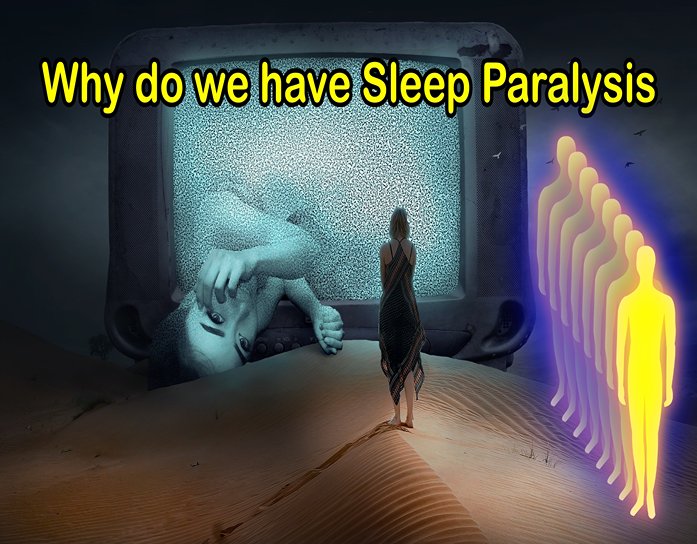Table of Contents
Why do we have Sleep Paralysis
Sleep paralysis (SP) is a phenomenon that occurs during the transition between sleep and wakefulness. It is a state in which the body is temporarily unable to move and often accompanied by vivid hallucinations or a sense of dread. While it can be a terrifying experience, sleep paralysis is a relatively common occurrence, affecting around 8% of the population. In this blog post, we will explore the reasons why we have sleep paralysis (SP).
Firstly, it is important to understand that sleep paralysis occurs during a specific stage of sleep known as REM sleep. REM (rapid eye movement) sleep is a crucial stage of sleep during which we experience vivid dreams and our bodies become temporarily paralyzed to prevent us from acting out our dreams. During REM sleep, the brainstem, which controls basic life-support functions such as breathing and heart rate, becomes highly active, while the rest of the brain is largely shut down. This allows us to experience dreams without actually physically acting them out.
However, sometimes the transition between REM sleep and wakefulness can be disrupted, causing the brainstem to remain active while the rest of the brain begins to wake up. This can result in a state of sleep paralysis (SP), where the body remains paralyzed even though the brain is awake and conscious. The vivid hallucinations that often accompany SP are thought to be a result of the brain trying to make sense of the mismatch between the paralyzed body and the active brain.
There are several factors that can increase the likelihood of experiencing sleep paralysis (SP). One of the most significant is a disrupted sleep schedule or lack of sleep, as this can interfere with the natural transition between sleep stages. Certain medications or substances such as alcohol or stimulants can also increase the risk of sleep paralysis. Finally, individuals with certain sleep disorders such as narcolepsy or sleep apnea may be more prone to SP.
Sleep paralysis (SP) is a normal and relatively common occurrence that is caused by a disruption in the transition between REM sleep and wakefulness. While it can be a frightening experience, it is generally harmless and not indicative of any underlying medical conditions. By understanding the causes of SP, we can better manage our sleep schedules and minimize the risk of experiencing this phenomenon.
What is the main cause of Sleep Paralysis
Sleep paralysis is a temporary condition where an individual is unable to move their body or speak during the transition between sleep and wakefulness. This phenomenon is not harmful and usually lasts only a few seconds or minutes. However, it can be a terrifying experience, with many individuals reporting intense fear and vivid hallucinations during episodes of sleep paralysis. In this blog post, we will explore the main causes of SP.
The primary cause of sleep paralysis (SP) is a disruption in the sleep cycle, specifically during the REM (Rapid Eye Movement) stage of sleep. During REM sleep, the brain is highly active, and the muscles in the body are temporarily paralyzed to prevent the individual from acting out their dreams. However, when an individual experiences SP, their brain is conscious, but their muscles remain paralyzed.
There are two types of sleep paralysis:
Isolated sleep paralysis (SP) occurs infrequently and is often caused by external factors such as stress, anxiety, or lack of sleep.
Recurrent isolated SP, on the other hand, occurs more frequently and is often associated with underlying sleep disorders such as narcolepsy or sleep apnea.
Another cause of sleep paralysis(SP) is the interruption of the body’s natural circadian rhythm. Disruptions to the circadian rhythm, such as jet lag or shift work, can lead to sleep disturbances and increase the risk of sleep paralysis (SP).
Certain medications and substances, such as antidepressants and stimulants, have also been linked to an increased risk of sleep paralysis (SP). Additionally, some research suggests that genetic factors may play a role in the development of SP, with individuals who have a family history of the condition being more likely to experience it themselves.
Sleep paralysis (SP) is caused by a disruption in the sleep cycle and is often associated with underlying sleep disorders, interruptions to the circadian rhythm, and certain medications and substances. While the experience can be distressing, it is usually not harmful and can be managed through healthy sleep habits and lifestyle changes. If you experience recurrent episodes of SP, it is important to speak with a healthcare provider to rule out any underlying medical conditions.
How long is sleep paralysis?
The duration of a sleep paralysis (SP) episode can vary, but it typically lasts only a few seconds to a few minutes. During this time, an individual is unable to move or speak, but they are usually aware of their surroundings and can breathe normally. The experience of SP can feel much longer than it actually is due to the intense fear and vivid hallucinations that often accompany it.
In rare cases, sleep paralysis (SP) episodes can last longer than a few minutes, and in some cases, they may be a sign of an underlying sleep disorder such as narcolepsy or sleep apnea. If an individual experiences frequent or prolonged episodes of SP, they should speak with a healthcare provider to rule out any underlying medical conditions and receive appropriate treatment.
The experience of SP can be frightening, but it is generally not harmful and does not require medical intervention unless it is associated with an underlying sleep disorder.
What happens after sleep paralysis?
After a sleep paralysis (SP) episode, an individual typically returns to normal wakefulness. The paralysis of the muscles gradually wears off, and the individual regains the ability to move and speak. The intense fear and vivid hallucinations that often accompany SP may persist for a short time after the episode has ended, but they typically subside once the individual has fully awakened.
Some individuals may experience residual effects after SP, such as a lingering sense of anxiety or fear. It is important to note that these feelings are a normal response to a frightening experience and should gradually dissipate over time.
In some cases, an individual may experience multiple episodes of SP, either on the same night or on subsequent nights. While this can be distressing, it is generally not harmful and is not indicative of an underlying medical condition.
The experience of SP can be unsettling, but it typically does not have any long-term effects and should not interfere with an individual’s ability to function normally during waking hours. If an individual experiences frequent or prolonged episodes of SP, they should speak with a healthcare provider to rule out any underlying medical conditions and receive appropriate treatment.
How do I stop sleep paralysis?
While sleep paralysis can be a distressing experience, there are some things you can do to reduce the frequency of episodes or prevent them altogether.
Establish a regular sleep routine: Maintaining a consistent sleep schedule, including going to bed and waking up at the same time each day, can help regulate your sleep cycle and reduce the likelihood of experiencing SP.
Reduce stress and anxiety: High levels of stress and anxiety can disrupt your sleep and increase the risk of SP. Consider incorporating relaxation techniques such as meditation, deep breathing exercises, or yoga into your daily routine to reduce stress and promote relaxation.
Improve sleep hygiene: Good sleep hygiene practices can help promote better quality sleep and reduce the risk of sleep paralysis. This includes avoiding caffeine and alcohol before bed, avoiding screens for at least an hour before bedtime, and creating a dark and quiet sleep environment.
Treat underlying medical conditions: If you have an underlying medical condition such as sleep apnea or narcolepsy, it is important to receive appropriate treatment to manage your symptoms and reduce the risk of sleep paralysis.
Seek professional help: If you experience frequent or prolonged episodes of sleep paralysis that interfere with your quality of life, consider speaking with a healthcare provider or sleep specialist. They can help identify any underlying medical conditions and provide treatment options to manage your symptoms.
It’s important to remember that sleep paralysis is usually not harmful and does not require medical treatment unless it is associated with an underlying sleep disorder. By making lifestyle changes and seeking appropriate medical care when necessary, you can reduce the likelihood of experiencing SP and improve your overall sleep quality.













